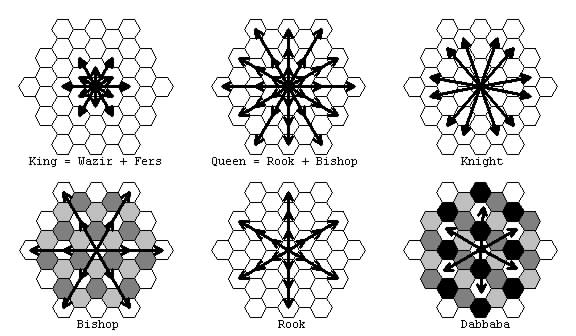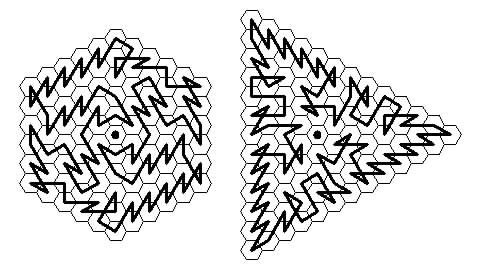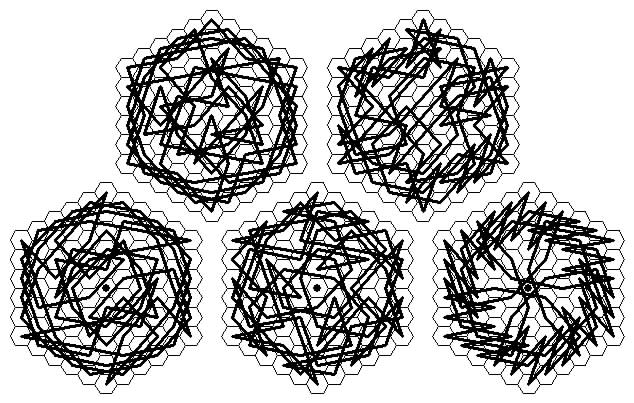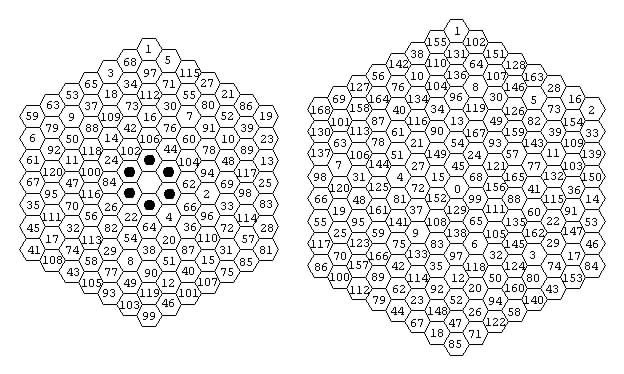
Sections on this page: — Hexagonal Chess Pieces
— Board Shapes
— Wazir Tours
— King Tours
— Knight Tours
— Longer Leaper Tours
— The Seven-Leaper
As is well known, there are just two ways of covering a plane area with regular polygonal tiles all of the same shape, size and orientation, namely by squares or hexagons. Equilateral triangles can also tile an area, but they must occur in two orientations. Without the restrictions on size, regularity and orientation, or on all the tiles being the same shape, there are of course many other types of coverings. The study of these is a subject in itself, known as tessellation. Here we confine our attention to the hexagon pattern, which occurs in nature in the bees' honeycomb. A playing area covered with hexagons is also termed a hex-board. It may be pointed out that it is difficult to draw regular hexagons in most computer drawing programs. The diagrams that follow have been produced by drawing irregular hexagons, by joining dots in a square array, and resizing them to give an approximation to regularity.
Many forms of variant chess have been developed that make use of boards with cells in the honeycomb pattern, usually termed Hexagonal Chess. Most of these variants agree in naming the pieces by analogy with the square-board game. As on boards of squares, moves can be described by two coordinates, but with 120° instead of 90° between the two coordinate lines.

The {0,1}-mover which passes through the edges of the hexagons is termed wazir, and the {1,1}-mover which passes through the corners of the hexagons is fers. The corresponding long-range riders in these directions are rook and bishop. As on the squares the honeycomb bishops are confined to a part of the board only, but there are three types instead of two. Their domains on the board are usually distinguished by tri-coloured "chequering" of the honeycomb.
The combination of wazir and fers is the king and that of rook and bishop is the queen. The shortest skew leaper, i.e. to cells not reachable by the queen from the same cell, is the hexagonal chess knight and is the {1,2}-mover, as in square chess. The {0,2} mover, called a dabbaba, defines a different "chequering" of the board, requiring four colours. Intuitively this seems rather strange on a board with structure based on threes and sixes.
Taking as unit the centre-to-centre distance of hexagons with a common side it is possible to calculate the length of a move from centre to centre of any cells on the honeycomb by using the modified Pythagorean formula Ö(u² + v² + uv). Thus the numerical values of the lengths are different from those for the corresponding square-board pieces with the same move coordinates. For example, while the wazir move is still of length 1, the fers is now a Ö3 mover (instead of Ö2) and the knight is a Ö7 mover (instead of Ö5).

The first double-pattern fixed distance leaper on the honeycomb is the 7-leaper (analogous to the 5-leaper on the chessboard). Its two components are {0,7} and {3,5}. The next case, also shown in the above diagram is the Ö91-leaper whose components are {1,9} and {5,6}.
The number of cells in a hexagon-shaped board of honeycomb pattern with n cells in a rook line along each side (2n−1 cells in the rook move through the centre) is 3n(n−1) + 1, as can be visualised by removing the centre cell and cutting the remainder up into three parallelograms, each of n by (n−1) cells. This formula can also be expressed as n³ − (n−1)³ since the board can also be visualised as three faces of a cube formed of near-spherical cells, the central hexagon being a corner of the cube. The sequence runs: 1, 7, 19, 37, 61, 91, 127, 169, 217, 271, 331, 397, 469, 547, 631, 721, 817, 919, 1027, ...
There are also less familiar hexagon-shaped boards where the edge cells are in bishop lines. The number of cells works out at 9n² − 15n + 7. The sequence runs: 1, 13, 43, 91, 157, 241, 343, 463, 601, 757, 931, 1123, ....
It may be noted here that, unlike boards of squares, honeycomb boards can occur in two orientations on the page, namely with sides of the hexagonal cells vertical or horizontal. We use both orientations, but tend to orient axially symmetric tours so that the axis is vertical, which makes the symmetry more readily apparent to the human eye.
Other shapes of honeycomb board can also be used: Triangular boards, where the number of cells is n(n+1)/2 when the sides are rookwise (1, 3, 6, 10, 15, 21, 28, 36, 45, 55, 66, 78, 91, 105, ...), but 3n(n+1)/2 + 1 when they are bishopwise (1, 4, 10, 19, 31, 46, 64, 85, 109, ...). Lozenge-shaped boards, where the number is of course n^2 when the sides are rookwise, since it is merely a distorted square (1, 4, 9, 16, 25, 36, 49, 64, 81, 100, ...), but n² + 2(n−1)² when the side is bishopwise (1, 6, 17, 34, 57, 86, 121, ...).
On the 7-cell hexagon there is one (geometrically distinct) closed wazir tour, axially symmetric, and one centreless closed tour hexasymmetric.
On the 13-cell board there is also one centreless hexasymmetric closed tour, and four geometrically distinct open tours. Paths through the outer six cells are fixed, forming the star-shaped centreless circuit. The four open tours either have an end at the centre or pass through it at angles of 60°, 120° or 180° - this last is centrosymmetric.

On the 19-cell hexagon I have found 42 centreless tours of which 12 (shown here) are symmetric, 1 with a triple axis (and 120° rotation), 6 with a single axis, of the others 1 is unchanged by rotation of 60° (the "cogwheel" pattern), 1 by 120° and 3 by 180°.
On this board I also find 107 geometrically different closed wazir tours, none symmetric. They consist of 49 with a 60° angle at the centre, 40 with a 120° angle and 18 with a 180° angle (i.e. a straight path). The last four diagrams show the tours with the maximum of 7 "straight angles", these are in other words rook tours of the fewest possible (12) moves. There are nine tours with the minimum of two straight angles.

Here are some wazir tours of larger hexagonal boards, 37, 43, 61 and 91 cells. The two shapes of 91-cell board can be transformed from one to the other simply by moving six cells.

Here are some wazir tours of the smaller triangular hex-boards. It may be noted that those boards with side n = 3k or 3k−1, which are those with a multiple of 3 cells, are centred on a corner where three cells meet, while boards with side n = 3k+1 have a central cell. Trianguar hex-boards with bishop-move sides have no wazir tours since there is only one wazir move at each corner cell.

Here are symmetric centreless tours by a hex-king on the 91-cell hexagonal and triangular boards. The triangular tour, with 120° symmetry has alternating wazir and fers moves, this is possible since 90/3 = 30, an even number. The hexagonal tour, with 180° symmetry cannot quite alternate, since 90/2 = 45 is an odd number.

On the 13-cell hexagonal board there is a uniquely defined 12-move centreless knight tour, forming a twelve-pointed star (with six long points and six short points). This is the maximum type of symmetry on a board of hexagons, with 6 axes and 1/6 cycle rotation (analogous to octonary on a board of squares, with 4 axes and 1/4 cycle rotation).
The net of 36 knight moves on the 19-cell board consists of a pattern of 12 moves, repeated three times. There are four moves from every cell (except the centre where the knight cannot move). A closed centreless tour consists of 18 moves, 12 of which take it through the inner ring cells and the other 6 are edge to edge moves. A complete circuit of 4 edge to edge moves cannot be omitted since the moves through the four outer cells concerned then form a short circuit of 8 moves. So the three four-move circuits must be broken up in the patterns 3:2:1 or 2:2:2. The 3:2:1 type must be asymmetric. Among the 2:2:2 type I find 9 with a single axis, 1 with three axes (and 120° rotation), 5 with simple 180° rotational symmetry, and 1 with 60° rotary symmetry. The two special cases are drawn here with bold lines. The enumeration is tricky, since the human eye finds it difficult to recognise rotations or reflections of these tours as being the same.

The following are some tours of the size 4 (37-cell) hexagon. Axial symmetry is still possible on this board, in a centreless tour, since there are only two cells on the bishop-move axis. I show two axial tours, a triaxial tour (with 120° rotation) and a 180° rotational tour. A tour with 60° rotational symmetry is not possible on this board, since the moves between the inner edge cells form two hexagons, which are closed circuits. It is however possible on the 43-cell hexagon but only two solutions of this type are possible. I have not studied other types to any extent, the third example on this board is one with 120° rotary symmetry that I happen to have made.

Axial symmetry is not possible on hexagon boards of more than 37 cells, but rotary symmetry is possible, in centreless tours; this can be of three degrees: bi-, tri- or hexa- in which the smallest rotations that leave the pattern unchanged are 180°, 120° and 60° respectively. The following are some tours of the size 5 board (61 cells). There can't be many 60° tours because the restrictions are very tight; these two were constructed while writing this article (5 April 2011):

The following are the first knight's tours on hexagon boards that were published (G.P.Jelliss, Chessics #7, 1979, pp.4-5). They use the Glinskian board of 91 cells. Such tours are easier to construct than those on the squared board or smaller hexagons since three hexagonal chess knight moves can form a triangle, and it is often possible to join in a cell that has been missed out of an attempted tour by deleting one move and diverting the path through the omitted cell. This method was used to construct the first tour shown here, which was completed and sent to Wladislaw Glinski, inventor of the most popular form of Hexagonal Chess, which uses this board, on 10 January 1974. This method of course always results in tours containing 60° angles. However the second tour shows that, by different methods, a tour without 60° angles can be constructed.

These first two tours are asymmetric. Centrosymmetric closed knight tours of hexagon boards are impossible, because the 3n(n−1) + 1 moves must fall into twos or threes symmetrically placed, and the odd one left over must therefore be a move symmetric with itself, i.e. bisected by the centre point of the board, but no knight move passes over the centre of any cell. The other three tours, from the same source, show bi-, tri- and hexa- symmetric closed centreless tours of the 91-cell board.
We now turn to other shapes of honeycomb boards. The only note I have concerning knight tours on triangular honeycombs is that the smallest board on which the knight can move on every cell is the 15-cell triangle, with 5 cells along each side, but the moves through the corner and centre cells form a 6-move circuit, so no closed tour is possible.
Some tours on lozenge-shaped boards were made by H. E. de Vasa, who also invented a form of chess on this type of board. Some results were given late issues of Fairy Chess Review (problems 9941, 1954 and 10056, 1955). These gave a knight tour of a 36-cell lozenge (and it was mentioned that the smallest board on which a tour is possible is the 25-cell), and knight tours on an 81-cell lozenge showing the square numbers on (a) the short and (b) the long diagonal, in order of magnitude.
12 22 38 19 28 48 56 62 81 01 21 13 11 19 32 23 29 74
20 27 11 57 37 80 60 64 35 10 04 02 22 30 26 15 33 76
18 13 21 26 63 58 49 55 61 06 18 09 14 44 75 31 24 46
23 39 17 29 47 36 79 59 50 20 12 05 16 08 77 28 73 34
30 10 14 07 25 65 5 34 54 03 07 19 27 25 45 59 78 63
08 24 02 16 33 06 74 66 44 52 38 40 43 54 36 66 47 72
40 31 09 46 03 78 68 51 71 42 55 51 58 79 62 49 35 69
15 04 77 73 42 70 53 75 67 57 53 37 67 60 70 80 64 48
01 41 32 05 76 72 43 69 52 39 41 56 50 65 68 61 71 81
Some other results were mentioned but regrettably not diagrammed.
The next leaper longer than the knight is the alfil = {2,2} = Ö12, but this being a bishop move is confined to cells of one colour. The next longer is the camel = {1,3} = Ö13 which is a free leaper on the honeycomb, able to reach any cell from any other in a series of leaps on a sufficiently large board (unlike the camel on squared boards which is confined to cells of one colour). Here is an asymmetric closed tour by such a hex-camel (G.P.Jelliss, July 1974, but not published before).

The next longer leapers are the zebra = {2,3} = Ö19 and the giraffe = {1,4} = Ö21. The giraffe is confined to one third of the cells, but the zebra is another free leaper. The diagram (G.P.Jelliss, 30 September 1980, but not published before) shows hexasymetric paths of the zebra of 66 moves and 24 moves which together cover the whole 91-cell board except the centre cell. A hexasymmetric zebra tour in one circuit is impossible on this board.
The smallest rook-wise hexagonal board on which a 7-leaper can move is the size 5 (61 cells). On this board it can tour the outer ring of cells in a unique hexasymmetric fashion, all its moves being of the same type {3,5}. The 7-leaper can also reach six other cells, a wazir step in from each corner, but these are dead ends with no way out but by a {0,7} leap to the opposite corner.

On the size 6 board (91 cells) the 7-leaper can tour the outer three rings of cells. This tour also uses only the {3,5} leap but is only tri-symmetric. We show it in numerical form as a graphical representation would be unclear. Again there are 6 cells, marked by dots, that the 7-leaper can reach by a {0,7} leap from each of the corner cells, but with no way out.
On the size 7 board (127 cells) the 7-leaper can reach every cell except the centre, and can tour all except the inner 7 cells. This tour is trisymmetric and uses both types of 7-leap.

The size 8 board (169 cells) is the smallest hexagonal board on which the 7-leaper can make a complete tour. The tour as a whole is asymmetric, but by omitting the centre cell (numbered 0) and making the last leap from 168 to 1 the resulting centreless tour is bi-symmetric. This tour also makes a lot more use of the rookwise 7-leap than the other tours do. (The above 7-leaper results are from G.P.Jelliss, Chessics #11, 1981, pp.1, 8-9).
The smallest triangular board of hexagonal cells on which the 7-leaper can move from every cell is the 105 cell triangle with 14 cells along the sides. However no closed tour is possible, since there are 15 cells in the central area where the 7-leaper has only two moves, and the moves through nine of these form three six-move circuits.